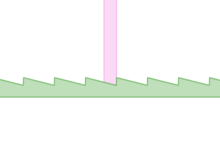This articleneeds additional citations forverification.(November 2023) |
Aratchet(occasionally spelledrachet) is a mechanical device that allows continuous linear or rotary motion in only one direction while preventing motion in the opposite direction. Ratchets are widely used in machinery and tools. The wordratchetis also used informally to refer to a ratchetingsocket wrench.

Red arrows indicate which way force is applied to the gear.


Red arrows indicate which way force is applied to the gear rack. The rack and pawl are both restricted to onlylinear movement(not shown).
Theory of operation
editA ratchet consists of a roundgearor a linearrackwith teeth, and a pivoting, spring-loaded finger called apawl(orclick,in clocks and watches[1][2]) that engages the teeth. The teeth are uniform but are usuallyasymmetrical,with each tooth having a moderate slope on one edge and a much steeper slope on the other edge.
When the teeth are moving in the unrestricted (i.e. forward) direction, the pawl easily slides up and over the gently sloped edges of the teeth, with a spring forcing it (often with an audible 'click') into the depression between the teeth as it passes the tip of each tooth. When the teeth move in the opposite (backward) direction, however, the pawl will catch against the steeply sloped edge of the first tooth it encounters, thereby locking it against the tooth and preventing any further motion in that direction.
Backlash
editBecause the ratchet can only stop backward motion at discrete points (i.e., at tooth boundaries), a ratchet does allow a limited amount of backward motion. This backward motion—which is limited to a maximum distance equal to the spacing between the teeth—is calledbacklash.In cases where backlash must be minimized, a smooth, toothless ratchet with a high friction surface such asrubberis sometimes used. The pawl bears against the surface at an angle so that any backward motion will cause the pawl to jam against the surface and thus prevent any further backward motion. Since the backward travel distance is primarily a function of the compressibility of the high friction surface, this mechanism can result in significantly reduced backlash.
In theoretical physics
editIn theoreticalstatistical physics,the concept of a ratchet, often termed a "Brownian Ratchet,"is used to explain the origin of directed motion arising from a combination oftime-reversal symmetrybreaking andleft-right symmetrybreaking. When non-thermal forces (e.g. alternating pushes and pulls) are applied to an asymmetric substrate (e.g. an asymmetric gear), directed motion generically appears. This principle is known as the "Ratchet Principle" or "Curie's Principle," afterPierre Curie.[3]
While the ratchets referenced in statistical physics are typically at the molecular or microscopic scales, the concept was inspired by the ratchet and pawl in its introductions byMarian SmoluchowskiandRichard Feynman.
Uses
editRatchet mechanisms are used in a wide variety of applications, including these:
Gallery
edit-
Ratchetingsocket wrenchor spanner.
-
A ratchet leverhoist,also known as a 'come-along.'
-
The ratchet mechanism of acable tie.
-
Setting thebezelof adiving watchto the start time of a dive. For safety reasons, the ring has a ratchet so it cannot be turned or knocked in the opposite direction.
See also
edit- Brownian ratchet
- Sprag clutch
- Check valve,a device that allows fluids to flow in only one direction
- Diode,a device that allows electric current to flow in only one direction
References
edit- ^hautehorlogerie.org
- ^"Know your terminology – Clocks".Hints and Tips.British Horological Institute. Archived fromthe originalon 2008-06-07.Retrieved2008-05-15.
- ^Reimann, Peter (April 2002)."Brownian motors: noisy transport far from equilibrium".Physics Reports.361(2–4): 57–265 – via Elsevier Science Direct.